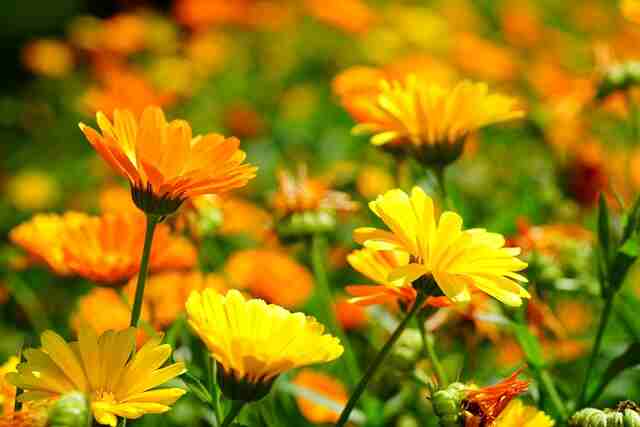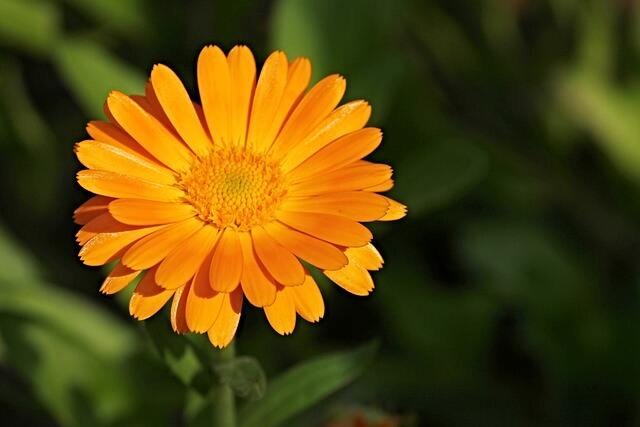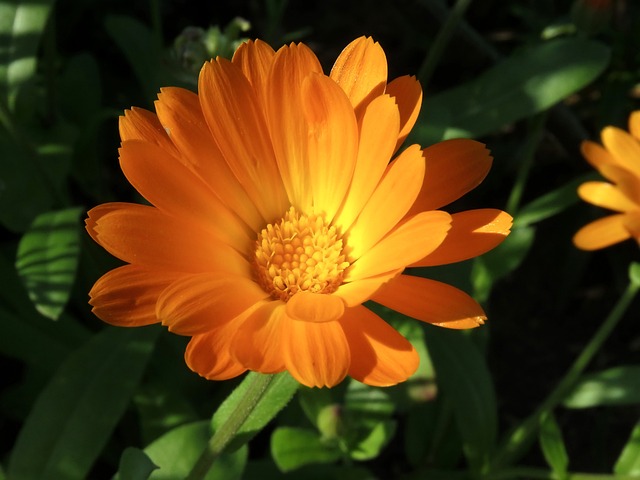Do you want to add some beauty to your garden along with some medicinal and health benefits?
Then why don’t you go for Calendula?
Calendula, also known as the “pot marigold,” is a stunning and versatile plant that can be grown in gardens or containers. With its bright and cheerful blooms and numerous health benefits, it’s no wonder why calendula has been used for centuries in culinary, medicinal, and beauty applications. If you’re interested in growing calendula in your garden, but don’t know where to start, you’ve come to the right place.
In this detailed guide, we’ll provide you with all the information you need to successfully grow and care for calendula, from planting to harvesting and everything in between.
Whether you’re a seasoned gardener or a beginner, this guide will give you the tools and knowledge you need to enjoy this beautiful and beneficial plant. So, let’s get started and discover the wonders of growing calendula!
Brief overview of Calendula
Calendula, also known as the “pot marigold,” is a beautiful and versatile plant that belongs to the daisy family. This plant is native to the Mediterranean region, but it is now widely cultivated all over the world.
It can be easily grown in gardens or containers and can bloom for months, adding a cheerful burst of color to any garden. Not only is it aesthetically pleasing, but it also has various medicinal, culinary, and beauty applications, making it a valuable addition to any home garden.
It is known for its anti-inflammatory, antiseptic, and soothing properties, and it’s used in skincare products, teas, and even cooking. In this guide, we’ll cover everything you need to know to successfully grow and care for calendula, from planting to harvesting and using it in various applications.
Importance and uses of Calendula

Calendula is a plant that has been used for centuries for its various health benefits and applications. It has anti-inflammatory, antiseptic, and antibacterial properties, making it a valuable addition to many natural remedies and beauty products. It is known to soothe irritated and inflamed skin, making it a popular ingredient in creams, lotions, and ointments. It is also used in teas and tinctures to help reduce fever and inflammation.
In addition to the medicinal uses of calendula, it is also used in culinary applications. The petals can be used fresh or dried and added to soups, stews, and salads for a burst of color and flavor. It is also used to add a floral note to desserts and baked goods.
Furthermore, calendula has been used for centuries in traditional medicine as a remedy for various ailments, including digestive issues, menstrual cramps, and skin conditions. The plant is rich in antioxidants, making it a valuable addition to any diet or skincare routine.
Overall, It is a versatile and beneficial plant with numerous uses and applications, making it a valuable addition to any home garden or natural remedies toolkit.
When and Where to plant Calendula?
Calendula can be planted in both outdoor garden beds and indoor containers. The timing and location of planting will depend on your climate and growing zone.
In general, It can be planted in the spring after the last frost has passed. In warmer regions, it can also be planted in the fall for a second season of blooms. It prefers cooler temperatures and can tolerate light frost.
When choosing a location for planting, look for a spot with full sun to partial shade and well-draining soil. Calendula can also tolerate poor soil conditions, but adding compost or aged manure can improve soil fertility and drainage.
If planting in containers, make sure to choose a pot with drainage holes and use a well-draining potting mix. It can be grown in containers year-round and moved indoors during the colder months in colder climates.
Overall, calendula is a versatile plant that can be grown in a variety of locations and climates. With proper care and attention, it can bloom for months and add a cheerful burst of color to any garden or indoor space.
How to plant Calendula?
Calendula is an easy plant to grow and can be cultivated both indoors and outdoors. Here are the steps to plant calendula:
Choose a location
Calendula prefers full sun but can also tolerate partial shade. So choose your location wisely with well-draining soil and good air circulation.
Prepare the soil
Loosen the soil to a depth of 6-8 inches and amend it with compost or aged manure to improve drainage and fertility.
Sow the seeds
Calendula seeds can be sown directly in the garden bed after the last frost or started indoors 6-8 weeks before the last frost. Sow the seeds thinly and cover them with a thin layer of soil.
Water and care
Keep the soil evenly moist, but not waterlogged. Once the seedlings have grown a few inches tall, thin them to a distance of 12-18 inches apart. Fertilize your plants with a balanced fertilizer once in a month.
Harvesting
Calendula flowers can be harvested as soon as they fully bloom. Pick the flowers in the morning when they are fully open, and the petals are dry.
With these simple steps, you can easily grow this plant and enjoy its beautiful blooms and numerous benefits.
How to Care for Calendula?

Soil
Calendula is a relatively low-maintenance plant that can thrive in various soil conditions. It can tolerate poor soil conditions and is known to be a natural soil cleanser, as it absorbs toxins from the soil. However, to ensure healthy growth and abundant blooms, it is essential to provide it with well-draining soil that is not too rich in nutrients.
When planting calendula, it is crucial to prepare the soil properly by loosening it to a depth of 6-8 inches and amending it with compost or aged manure. This helps to improve soil structure and drainage, allowing for healthy root growth and better water retention.
Overall, providing it with good soil conditions is key to its success in the garden. With the right soil preparation and proper care, calendula can produce beautiful blooms for months and add a cheerful burst of color to any garden or indoor space.
Light
Calendula plants require full sun to partial shade for optimal growth and bloom production. They can tolerate some shade but may produce fewer blooms and have leggy growth. In general, these plants need at least 6 hours of direct sunlight each day to thrive.
If planting calendula indoors, make sure to place the containers near a sunny window or under grow lights to ensure they receive enough light. In hotter climates, partial shade during the hottest part of the day can help protect the plants from sunscald and keep them from drying out.
Overall, providing these plants with enough light is crucial for their growth and bloom production. With the right amount of sunlight, calendula can produce an abundance of colorful flowers that will brighten up any garden or indoor space.
Water
Calendula plants require regular watering to maintain healthy growth and bloom production. The frequency of watering will depend on the weather conditions, soil type, and size of the plant. As a general rule, it should be watered deeply once a week or when the soil feels dry to the touch.
It is essential not to overwater it, as this can lead to root rot and other fungal diseases. Watering should be done at the base of the plant to avoid wetting the foliage, which can promote disease. It is also recommended to water early in the morning to allow time for the foliage to dry before nightfall.
In summary, providing calendula with regular, deep watering and avoiding overwatering is essential to maintain healthy growth and blooming.
Temperature
Calendula plants are hardy annuals that can tolerate a range of temperatures. They prefer cool to moderate temperatures and can tolerate light frost. The optimal temperature range for calendula growth is between 60 and 70 degrees Fahrenheit.
In hot climates, it may struggle to thrive during the summer months and may benefit from partial shade or cooler evening temperatures. In colder climates, calendula may need protection from harsh winter temperatures or can be grown as a winter annual.
Overall, it can tolerate a wide range of temperatures but prefers cooler temperatures for optimal growth and bloom production. With proper care and attention to temperature fluctuations, it can provide a beautiful burst of color to any garden or indoor space.
Humidity
Calendula plants prefer moderate humidity levels and can tolerate a range of humidity conditions. They do not typically require high humidity and can withstand periods of dry air.
In hot, dry climates, it may benefit from occasional misting to increase humidity levels around the plant. However, it is important to avoid getting the foliage wet, as this can promote fungal growth and disease.
In areas with high humidity levels, calendula may be more prone to fungal diseases and should be monitored closely for any signs of leaf spot or other issues. Proper air circulation around the plant can help prevent humidity-related problems.
Overall, calendula is a hardy plant that can tolerate a range of humidity conditions, but moderate humidity levels are ideal for optimal growth and bloom production.
Fertilizer
Calendula plants do not require heavy fertilization, but they can benefit from occasional feeding to promote healthy growth and blooming. A balanced fertilizer that contains equal amounts of nitrogen, phosphorus, and potassium can be applied to your plant once a month during the growing season.
It is important not to over-fertilize calendula, as this can lead to excessive foliage growth at the expense of blooming. Organic fertilizers, such as compost or aged manure, can also be applied to provide additional nutrients to the soil.
In summary, providing it with occasional, balanced fertilization can promote healthy growth and bloom. However, it is important not to over-fertilize, and organic fertilizers can also be used to provide nutrients to the soil.
How to Prune and deadhead Calendula?
Pruning and deadheading calendula is important to promote healthy growth and blooming throughout the growing season. Deadheading, which is the removal of spent flowers, also prevents the plant from setting seed and can prolong blooming.
To deadhead calendula, simply remove the spent flower heads by cutting the stem just above a set of leaves. This encourages the plant to produce new flowers and prevents the energy from being diverted to seed production.
Pruning is done to control the size and shape of the plant. To prune calendula, simply pinch back the tips of the stems or cut back leggy growth to promote bushier growth.
It is important to note that pruning and deadheading should be done with clean and sharp tools to prevent damage to the plant. It is also recommended to prune and deadhead calendula regularly throughout the growing season for optimal growth and blooming.
Common pests and diseases

Calendula plants are generally hardy and resistant to many pests and diseases. However, like all plants, they can be susceptible to certain issues. Some common pests and diseases that can affect calendula plants include:
Aphids
These small, soft-bodied insects can suck the sap from the leaves and flowers of the plant, causing them to wilt and deform.
Spider mites
These tiny pests can cause yellowing and stippling of the leaves, as well as webbing on the plant.
Powdery mildew
This fungal disease appears as a white, powdery coating on the leaves and flowers of the plant and can cause stunted growth and reduced blooming.
Leaf spot
This fungal disease causes brown or black spots on the leaves of the plant and can lead to defoliation and reduced blooming.
To prevent these issues, it is important to provide proper care and maintenance to calendula plants, including regular watering, appropriate fertilization, and proper pruning and deadheading. Additionally, using insecticidal soap or neem oil can help control pests, while removing and disposing of infected plant material can help prevent the spread of fungal diseases.
Conclusion
Growing and caring for calendula plants is relatively easy and can be a great addition to any garden. By providing the right growing conditions, including well-draining soil, adequate sunlight, and regular watering, calendula plants can thrive and produce an abundance of colorful blooms. Proper pruning and deadheading can also promote healthy growth and blooming throughout the growing season.
While calendula plants are generally resistant to many pests and diseases, it is important to keep an eye out for common issues like aphids, spider mites, powdery mildew, and leaf spot. Regular care and maintenance, including appropriate fertilization and pest control measures, can help prevent these issues and keep calendula plants healthy and vibrant.
Whether you are an experienced gardener or a beginner, growing and caring for calendula plants is a rewarding and enjoyable experience that can add beauty and color to your outdoor space. So why not give it a try and see the beautiful results for yourself?
You may also like to read
How to Grow and Care for Heliotrope – A Beginner’s Guide
How to grow and care for crookneck squash – A detailed guide






